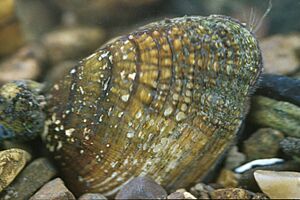Birdwing pearlymussel facts for kids
Quick facts for kids Birdwing pearlymussel |
|
|---|---|
 |
|
| Conservation status | |
| Scientific classification | |
| Genus: |
Lemiox
|
| Species: |
rimosus
|
| Synonyms | |
|
|
The birdwing pearlymussel (Lemiox rimosus) is a very rare type of freshwater mussel. It belongs to a family called Unionidae, which are often known as river mussels. This aquatic animal is a bivalve, meaning it has two shells that hinge together.
This special mussel is naturally found in the states of Tennessee and Virginia in the United States. Sadly, its population has shrunk by more than 90%. Because it is so rare, the United States government lists it as an endangered species. This means it is at high risk of disappearing forever.
Contents
Where Does the Birdwing Pearlymussel Live?
Today, the birdwing pearlymussel only lives in three rivers. These are the Duck River, the Clinch River, and the Powell River. All three rivers are located in Tennessee and Virginia.
This mussel used to live in many more rivers. However, it has been extirpated from those places. This means it no longer exists there, even though it might still be found elsewhere. For example, it is now completely extinct in the state of Alabama.
How This Mussel Helped Stop a Dam
In 1983, there was a big project to build the Columbia Dam on the Duck River. The dam was already half-finished. However, efforts to move the birdwing pearlymussel to other streams failed. Another endangered mussel, the Cumberland monkeyface pearlymussel, also could not be moved.
Because these mussels were endangered and could not be safely relocated, the construction of the Columbia Dam had to stop. This shows how important even small creatures like mussels can be for protecting our natural world.
How the Birdwing Pearlymussel Grows Up
The birdwing pearlymussel has a very interesting way of growing up. Its young are called glochidia larvae. These tiny larvae need a special "host" fish to help them develop. For the birdwing pearlymussel, an important host fish is the greenside darter (Etheostoma blennioides).
A Clever Lure
To get its larvae onto the fish, the mussel uses a clever trick. It has a part that looks just like a small aquatic snail. This "lure" attracts the greenside darter. When the darter tries to interact with the lure, the mussel releases its glochidia larvae.
Attaching to the Fish
The released glochidia then attach themselves to the fish's gills. They stay there for about one and a half to two months. During this time, they go through a process called metamorphosis. This means they change from larvae into tiny mussels.
Dropping Off and Growing
Once they have changed into mussels, they drop off the fish. They land on the riverbed, which is called the substrate. From there, they continue to grow into adult mussels. The glochidia larvae grow best in colder water temperatures. This is different from many other mussels and their host fish.


